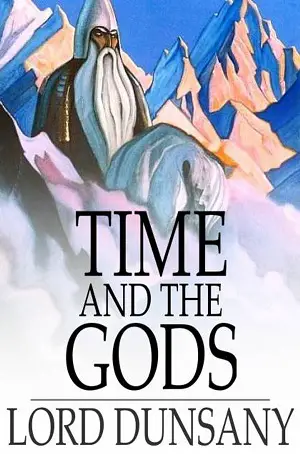Enter the fantastical realms of Lord Dunsany with our free collection of Lord Dunsany books in PDF format.
Lord Dunsany, a pioneer of modern fantasy, wove vivid tales filled with mythical lands, magical creatures, and poetic imagination. His works laid the foundation for the fantasy genre as we know it today.
From the enchanting The Gods of Pegāna to the epic adventures in The King of Elfland’s Daughter, Lord Dunsany’s stories transport readers to worlds of wonder and mystery, where the boundaries of reality fade away.
Ideal for fans of fantasy, mythology, and timeless storytelling, this collection offers a glimpse into the genius of an author who inspired legends like J.R.R. Tolkien and H.P. Lovecraft.
Download these Lord Dunsany books in PDF now and immerse yourself in the spellbinding works of one of fantasy’s true visionaries.
1) A Dreamer's Palace

A Dreamers Palace is a collection of fantastic tales that was first published in September 1910. It includes 16 stories and a preface. Among the tales included we can mention: “Poltarnees, Beholder of Ocean”, in which a man is sent to look over a mountain, to which, if any man climbs, he never returns.
In “The Madness of Andelsprutz” a man engages in a conversation with two others about whether or not the city of Andelsprutz is dead, to which one of the men tells that the city has a soul, he knows this because he saw it and engaged in a conversation with it.
In “The Hashish Man” the narrator meets a man who has visited the city of Bethmoora -the name of another of the stories included in the book- who tells him that the city was abandoned by order of Emperor Thuba Mleen of Utnar Vehi. Other stories are: “The Sword and the Idol'', “The Hashish Man”, “In Zaccarath'', “The Day of the Poll”, etc.
2) Don Rodriguez Chronicles of Shadow Valley

Don Rodriguez Chronicles of Shadow Valley is an amusing fantasy novel published in February 1922, also known as “The Chronicles of Rodriguez”. The protagonist, Rodriguez, is excluded from the inheritance of the family castle with the excuse that, given his skill with the sword, he should be able to earn his own wealth, besides his father, on his deathbed, sends him out into the world to make his own fortune.
With the company of his servant Morano -a sort of Quixote's Sancho Panza- Rodriguez sets out to roam the countryside in search of fortune and glory, living a series of extraordinary adventures that lead him to the mythical Shadow Valley.
One of the most remarkable aspects of this story is how it describes the differences in perception between a curious and knowledgeable mind, personified by Rodriguez, and a more practically focused mind, which would correspond to Morano.
3) Fifty One Tales

Fifty One Tales is a collection of fantasy literature first published in April 1915. The British and American editions differ in that each includes a story that the other omits, "The Poet Speaks with Earth" in the British version, and "The Mist" in the American.
The American version of the text was used in 1974 by the Newcastle Publishing Company for the third volume of the Newcastle Forgotten Fantasy Library, due to its great relevance within the genre of fantasy literature, being published as "The Food of Death: Fifty-One Tales".
As presumed by its title, it consists of 51 short stories, among which we can mention: "The Assignation", "Wind and Fog", "Death and the Orange", "The Worm and the Angel", "Alone the Immortals", "A Losing Game", "The Lonely Idol", "Lobster Salad", etc.
4) Tales of Three Hemisphere

Tales of Three Hemispheres is a collection of fantasy stories by Lord Dunsany.
The first edition was published in Boston (United States) by John W. Luce & Co. in November 1919; the first British edition was published in London by T. Fisher Unwin in June 1920.
The book collects 14 stories; the last three, under the general title of "Beyond the Fields We Know", are related stories, as explained in the editor's note preceding the first, "Idle Days on the Yann", previously published in the author's earlier collection, "A Dreamer's Tales", but reprinted in the present one because of its relationship to the other two.
5) Tales of Wonder

Tales of Wonderis a collection of short stories also known as “The Last Book of Wonder”, a title Dunsany preferred, the first edition of which was published in 1916. It could be said that Dunsany was ahead of the literature of his time, as his work is still relevant and feels modern even now.
Among his stories we have "A Tale of London", an amusing tale of a sultan seduced by the stories of London, is a tale that speaks to the mundanity of contemporary life. In "The City on Mallington Moor" a marble city appears to a drunkard on a desolate moor in the north of England.
In "The Secret of the Sea," ships are a kind of sentient entity; easily overcome by the will of their crew, but free to drift when the human crew is lost or incapacitated. Light the fire of imagination, amuse and transport yourself, with these 19 short stories of magical realism and intrigue.
6) The Gods of Pegana

The Gods of Pegana is Lord Dunsany's first book, published in 1905. It consists of a series of short stories starring fictional deities created by Dunsany, each with personality and power over human life, who inhabit Pegāna.
These deranged, cruel and somewhat insane deities amuse themselves by inflicting harm on their misguided worshippers. These are: Mana-Yood-Sushai, chief of all gods, who also created them and then fell asleep. When he awakens, he will return to create new gods and other worlds, and destroy what he has made. Skarl the Drummer, who eternally beats a drum to lull his creator to sleep, for if he stops doing so Mana-Yood-Sushai will awaken, and there will be no more worlds or gods.
Other gods are: Kib, Mung, Limpang-Tung, Roon, Hoodrazai, Mosahn, etc. Among the stories included in this book we can mention: "The Gods of Pegāna", "Of the Making of the Worlds", "The Chaunt of the Gods", "Concerning Sish", among others.
7) The Sword of Welleran and Other Stories

The Sword of Welleran and Other Stories is the third book by Anglo-Irish fantasy writer Lord Dunsany, considered a major influence on the work of J. R. R. Tolkien, H. P. Lovecraft, Ursula K. Le Guin and others.
George Allen & Sons first published it in hardcover in October 1908 and it has been reprinted several times since. Published by Modern Library in a combined edition with “A Dreamer's Tales” as “A Dreamer's Tales and Other Stories” in 1917.
The book is a series of short stories, some of them linked by Dunsany's invented pantheon of Pegāna-dwelling deities, which were the focus of his earlier collections The Gods of Pegāna and Time and the Gods.
One of the stories, "The Fortress Unvanquishable, Save for Sacnoth", was later (1910) published as a stand-alone book, in an Art-and-Craft-style limited edition, now very rare.
8) Time and the Gods

It is a series of short stories first published in September 1906. It is set in the same world as its predecessor (The Gods of Pegāna) and, as its name indicates, deals with the deities created by Dunsany.
InTime and the Godsthere is a whole mythology that oscillates between wonder and simplicity, with great insight and replete with beautiful prose, which is what makes it so engaging to read. Among his tales of mysticism and wonder are "Time and the Gods", "The Vengeance of Men", "The Cave of Kai", "For the Honor of the Gods", "Mlideen", "In the Land of Time", "The Dreams of the Prophet", etc.
Although some readers claim that the first few stories included are somewhat "weak", as one progresses one finds literary gems that inspire the desire to write a collection of fantastic tales of one's own. For its strong stories more than compensate for the weaker stories.
9) Unhappy Far off Things

In this book, Dunsany is more poetic, reflecting on the vestiges that survive from happier times. It leaves the impression that the Irish author was aware that a whole era had passed and looked back with nostalgia, longing for simpler times.
Specifically,Unhappy Far off Things is about France after World War I, capturing the desolation and ruins the villages suffered after the bombings, it is also about the people, but not as much. It focuses mainly on the decay of civilization, the destroyed French villages and the few surviving remnants of them.
Like many war-related stories, it presents us with a heartbreaking tale of man's stupidity and the innocent things that fall victim to it. It shows the horrors that can be caused by those who feed on hatred for anyone who does not belong to their group.







































